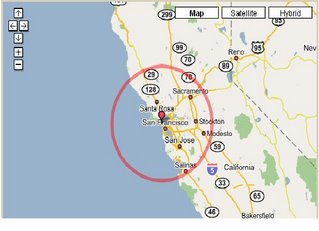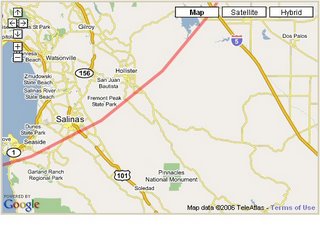
Beyond Organic. I've been following the local sustainable movement for awhile, and although I haven't pledged to eat within 100 miles of my home, I still make an effort to buy local when I can. If you don't go to your local Farmer's Market on a weekly basis, or subscribe to a farm participating as part of CSA , it's a bit difficult to stay within that 100 mile radius. Finding things mostly from California though, is not all that difficult. You can see my 100 mile radius above. However blowing it up a bit, thinking things from Salinas were in may not be the case, as the line ends just south of the urban area, and I think a lot of the farms are south of the town. And naturally Bakersfield is completely out, as is Fresno. The urban area to Citrus Heights is in for Sacramento, and luckily, Stockton is in my circle. I think trying the strict 100-mile radius is an interesting experiment, but wonder how practical it is for people outside of areas like California where there is a long growing season and abundant variety. Even in ancient times, people traded foodstuffs, they just used more ecological means of getting the goods around, such as by sailboat, or waterways, even digging canals.
However blowing it up a bit, thinking things from Salinas were in may not be the case, as the line ends just south of the urban area, and I think a lot of the farms are south of the town. And naturally Bakersfield is completely out, as is Fresno. The urban area to Citrus Heights is in for Sacramento, and luckily, Stockton is in my circle. I think trying the strict 100-mile radius is an interesting experiment, but wonder how practical it is for people outside of areas like California where there is a long growing season and abundant variety. Even in ancient times, people traded foodstuffs, they just used more ecological means of getting the goods around, such as by sailboat, or waterways, even digging canals.
The items below are foods which California is the #1 producer of in the US. California's percentage of the total U.S. crop are shown after the item.
Olives - 100%
Almonds - 99%
Walnuts - 99%
Figs - 98%
Kiwis - 97%
Pistachios - 96%
Apricots - 95%
Celery - 94%
Tomatoes - 94%
Broccoli - 93%
Plums - 93%
Nectarines - 93%
Strawberries 90%
Carrots - 89%
Lemons - 89%
Grapes - 88%
Garlic - 86%
Avocados - 84%
Dates - 82%
Lettuce - 78%
Peaches - 76%
Honeydew - 73%
Asparagus - 55%
Cantaloupe - 54%
Bell Peppers - 47%
Onions - 27%
Cabbage - 22%
Milk & Cream - 21%
Artichokes - 19%
Honey - 18%
Spinach-18%
If we followed the 100 mile rule across the US - well, at this moment, no one outside a circle very near California would enjoy Olives or Olive oil. I get most of mine in my local circle, from The Olive Press, where local olives are pressed on site. Since it's not available in stores, if I had to make a special trip for it (I pick it up on the way to visit my father in Sonoma), I think the gas I burn would make it a bad ecological proposition. Following the 100 mile plan would necessarily force a diversification of foods where diversification would be possible, but there is a large section of the country where the soil or climatic conditions aren't conducive to this. And the growing season may be short. The fine art of canning would need to be revived, or more regional canners spring up again. Our taste for fresh would have to change, and the health benefits we reap from having more fresh food would also be lost in some areas where year-round produce isn't possible. I'm all for reducing food miles, and using resources more efficiently, and I love local and seasonal, but I think there's a long way to go to make this practical for the masses across the country, and that's where it will have to reach in order to make the most ecological impact.
Saturday, November 25, 2006
Posted by
Anna Haight
at
9:59 AM
![]()
Labels: organic, sustainable
Subscribe to:
Post Comments (Atom)

No comments:
Post a Comment